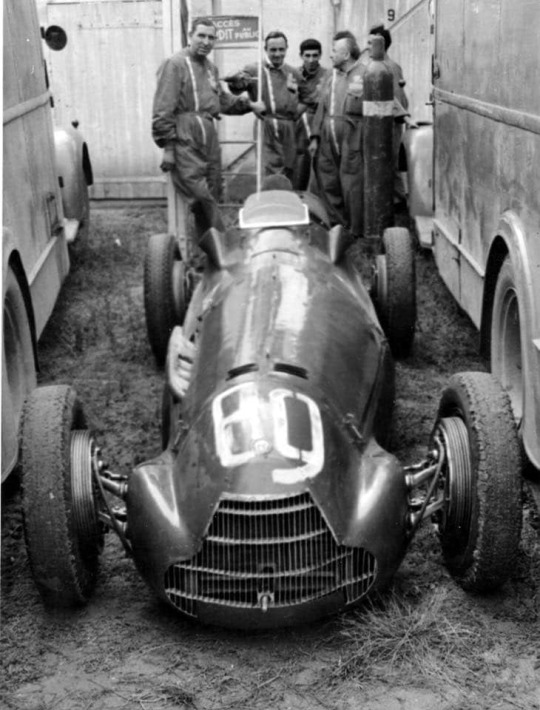#Alfa Romeo 158 Alfetta
Text
holy fuck the Alfa Romeo press release writer has once again absolutely knocked it out of the fucking park
The subtle tension between history and modernity is one that requires skill to manage. Skew any which way, and the result is out of balance: too backwards looking, or too focused on things to come. This difficult balancing act, however, can be very rewarding when done right, when the perfect mix of its ingredients is achieved: and this is what we set out to do in Imola, one of motorsport’s shrines.
Imola is a track that boasts an impressive history, dating back to its first race in 1953: it’s a circuit born in Italy’s motorsport heartland, with the help of Enzo Ferrari himself – there’s no bigger endorsement for a track in this country. Still, Imola was never a track to sit on its laurels: as a venue, it had to adapt, evolve, keep in tune with the times – in its layout and its identity. “Auto-motovelodromo Prototipo CONI di Imola” was always a mouthful, and the colloquial name of Circuito del Castellaccio – after a nearby hill – became Autodromo Dino Ferrari in 1970, and finally Autodromo Enzo e Dino Ferrari in 1988, as it played host to events such as the Italian and San Marino Grands Prix and, more recently, the Emilia Romagna Grand Prix. Many a time its corners were changed, with chicanes added, turns reprofiled, sections amended: Imola is a work of evolution, never ending and always morphing, but without ever losing its soul. Imola is Jim Clark and Nigel Mansell; it’s Alain Prost and Michael Schumacher. It’s obviously Senna. It’ll be the champions of tomorrow.
The space between tradition and the future is also one where Alfa Romeo lives and thrives. Since 1910, Alfa Romeo embodies the spirit of noble, Italian sportiness: under its aegis, some of the most iconic cars – both in motorsport and in the automotive industry – have come to life and gone on to inspire generations of car lovers. But Alfa Romeo is strongly focused on the future, with the daring ambition to reinvent sportiness for the 21st century. In the upcoming electrified world, Alfa Romeo cars will still embody passion, thrills, elegance. Alfa Romeo reinvents itself in each new car, without losing track of what makes it the brand it is: each future generation carrying within the spirit of the Alfetta 158 that led the brand from its motorsport beginnings.
We celebrate heading to Imola in this spirit. We honour our history and tradition, with our gaze firmly forward – to great things to come. In a city, Imola, itself combining a historical core with the modernity of its suburbs, we stand on the shoulders of giants and set out to write another page of Alfa Romeo history.
do you know how fuckin good you have to be to write the FUCK out of a grand prixview email like this? they have to be some sort of god tier writer, a giant walking among us.
71 notes
·
View notes
Text
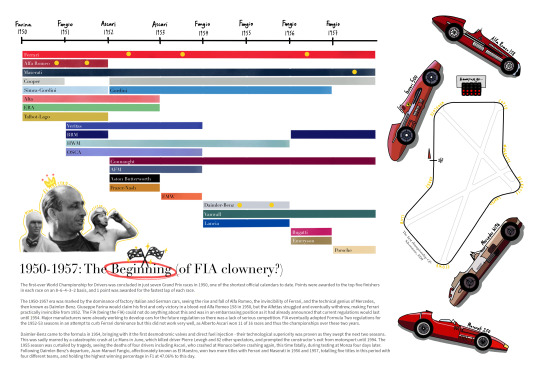
F1: a colorised history 1/10 - text and graphics mine with thanks to Wikipedia and Reddit
text in photo below the cut :) if you spot any mistakes please let me know!
The first-ever World Championship for Drivers was concluded in just seven Grand Prix races in 1950, one of the shortest official calendars to date. Points were awarded to the top five finishers in each race on an 8–6–4–3–2 basis, and 1 point was awarded for the fastest lap of each race.
The 1950-1957 era was marked by the dominance of factory Italian and German cars, seeing the rise and fall of Alfa Romeo, the invincibility of Ferrari, and the technical genius of Mercedes, then known as Daimler-Benz. Giuseppe Farina would claim his first and only victory in a blood-red Alfa Romeo 158 in 1950, but the Alfettas struggled and eventually withdrew, making Ferrari practically invincible from 1952. The FIA (being the FIA) could not do anything about this and was in an embarrassing position as it had already announced that current regulations would last until 1954. Major manufacturers were already working to develop cars for the future regulation so there was a lack of serious competition. FIA eventually adopted Formula Two regulations for the 1952-53 seasons in an attempt to curb Ferrari dominance but this did not work very well, as Alberto Ascari won 11 of 16 races and thus the championships over these two years, remaining the last Italian driver to do so.
Daimler-Benz came to the formula in 1954, bringing with it the first desmodromic valves and direct fuel injection - their technological superiority was proven as they swept the next two seasons. This was sadly marred by a catastrophic crash at Le Mans in June, which killed driver Pierre Levegh and 82 other spectators, and prompted the constructor's exit from motorsport until 1994. The 1955 season was curtailed by tragedy, seeing the deaths of four drivers including Ascari, who crashed at Monaco before crashing again, this time fatally, during testing at Monza four days later.
Following Daimler-Benz’s departure, Juan-Manuel Fangio, affectionately known as El Maestro, won two more titles with Ferrari and Maserati in 1956 and 1957, totalling five titles in this period with four different teams, and holding the highest winning percentage in F1 at 47.06% to this day.
#timeline#this is basically as close to fanart as i will ever get#tiny drawings of the 1950s cars#this was so ridiculously fun to do#can you believe it stemmed from watching seb name the wdcs in order one too many times#halfway through my fifth rewatch i was like#hey i don't really know about half of these people..#and so now i have taken it upon myself to do a Full And Comprehensive history of motorsport...#anyway i hope this is useful or at least nice to look at :")#because a lot of timeline spreadsheets ive seen are just uh. unusable#claire's edits#alberto ascari#juan manuel fangio#giuseppe farina#classic f1#f1#formula 1#i lowkey feel like this was designed very badly............... but OK#this was created for an audience of one (1) and that's me.#<3
15 notes
·
View notes
Text
0 notes
Photo

Alfa Romeo 158/159 "Alfetta" [1600x1067] 撸先生:看片神器,每日更新,高清流畅,无需翻墙,t.cn/EVvnoK4
0 notes
Text

Alfa Romeo
nel segno dell'eccellenza tecnica di tre volte CAMPIONE DEL MONDO - 1925, 1950, 1951 - ricorda alla clientela, agli sportivi, agli ammiratori, la sua produzione annuale: la 1900 e la 2500
Alfa Romeo
in the sign of the technical excellence of three times WORLD CHAMPION - 1925, 1950, 1951 - reminds customers, sportsmen, fans, its annual production: the 1900 and 2500
© Alfa Romeo, source Mille Miglia 1952 - XIX edizione Coppa Franco Mazzotti
#Alfa Romeo#Alfa Romeo 6c#classic car#vintage car#Alfa Romeo 158#Alfetta#Alfa Romeo 1900#Alfa Romeo 6C 2500 Sport berlina Pinin Farina#carrozzeria Pinin Farina#Pinin Farina#sport#World Champion#world championship#championship#campione del mondo#vintage advertising#vintage ads#1950s#50s#cars
114 notes
·
View notes
Text



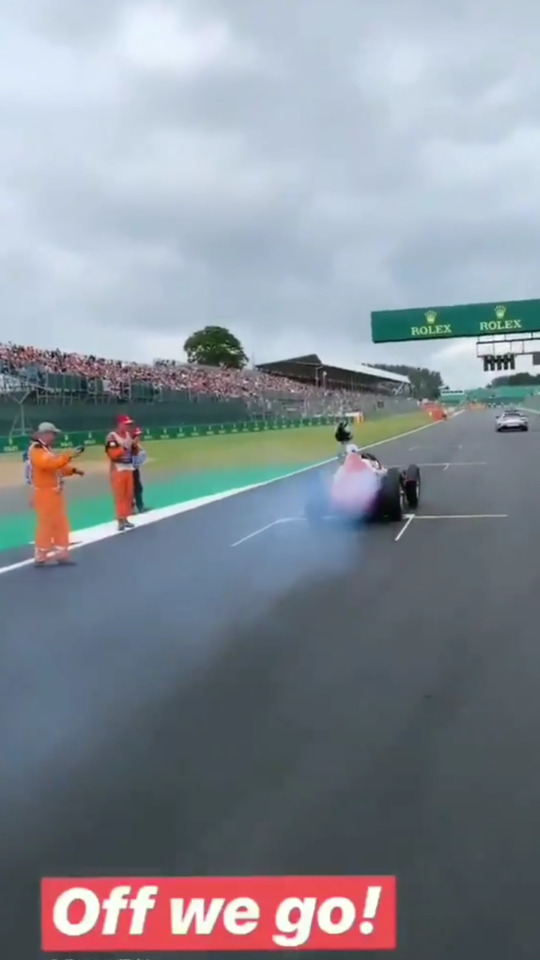
wonderful 💨💨💨😁
#kimi7#alfa romeo 158#alfetta#alfa romeo racing#alfa romeo#kimi raikkonen#retro#vintage#silverstone#british grand prix#off we go#giuseppe farina#f1#formula 1#formel 1
5 notes
·
View notes
Note
What are your fave photos of Kimi?
Firstly, this very dramatic shot... I love the black and white and the designs on his helmet and how that single visible eye of his is full of emotion. For me, this is an iconic photo and I have a similar one taken from a different angle on my camera roll, but it is in colour and I like this BW one more.
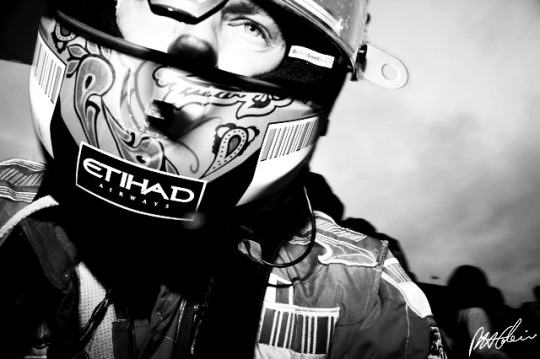
Simi, of course... This wasn't the first photo I saw of them that hooked me to their bromance. But look at the unintentional sensuality of this one. They both look breathless for each other and I am the gleeful cameraman watching them 😂
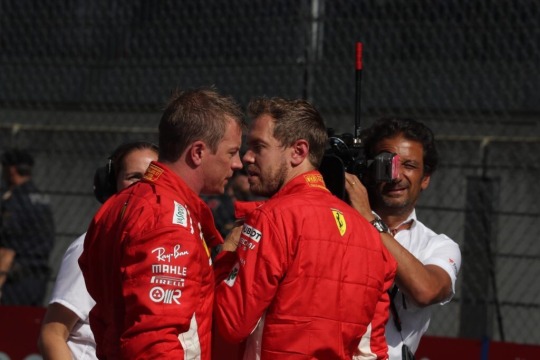
Then this one... He looks like a movie star here. The wind in his hair, the shoulders, the way he is sitting on the Ferrari he had just totalled... This looks just like a race poster from the 70's. Too bad I couldn't find it in better resolution.

Here is one I am putting up for purely aesthetical reasons... If he was on the grid today looking like this, he'd give everyone a run for their money. And he was in his prime as a driver, too... Chal who? Max which? Hey!

This one is here, because it sums up his attitude against life and Lotus!Kimi, ofc. God, I wish I had half of his level headedness.

Finns and their coffee! Rally!Kimi under the snow... This photo has such a dreamy quality that it always makes me stare at it for a little more than usual. What a soft guy! Angelic 😇

I like this photo a lot. We don't know much detail on their relationship, but once Kimi said he never had idols, but among the Ferrari drivers, he felt himself closer to Michael. He also considers Michael as his hardest rival and says he immensely enjoyed racing against him. I am sure it must have felt nostalgic to race against Mick, too.

Another iconic photo. Ron celebrates Kimi after he won Japanese GP 2005 in the final lap, having started the race from P17. In other photos from different angles it's so clear that Kimi smiles hugely, too. And it always warms my heart.
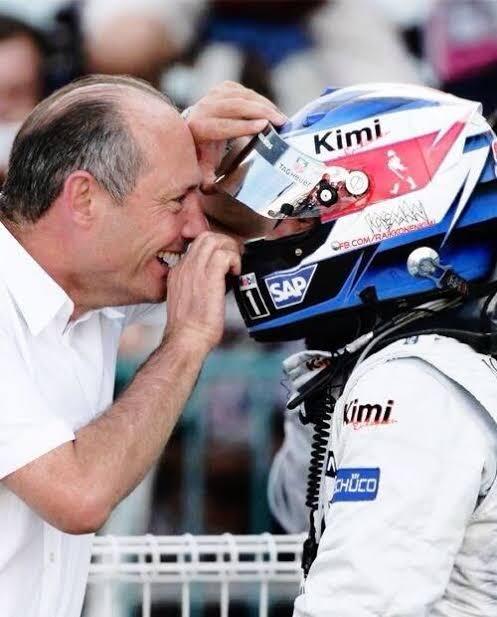
This beautiful car is Alfa Romeo Alfetta 158. Kimi drove this in British GP, in 2019. And would you look at this photo... It is like a still from a racing movie. He fits into the spirit of this car's history to a fault. And I am thankful Darren Heat caught and immortalized this frame.
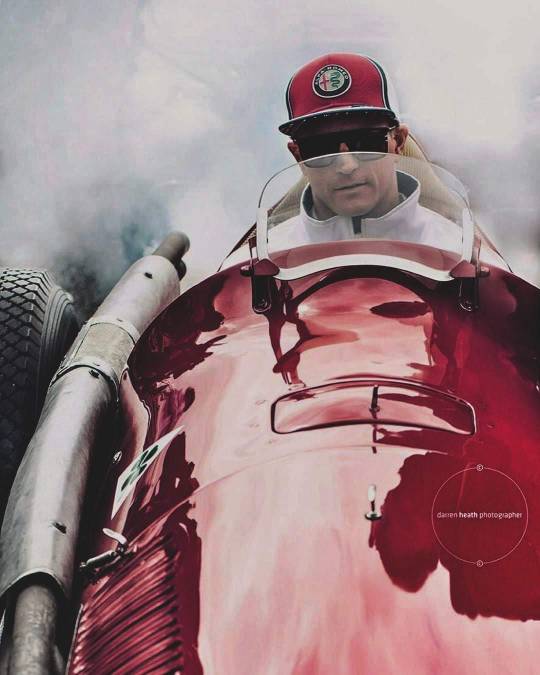
And lastly, I want to choose this one. It is from Turkish GP 2005. He is the first winner on my home race. I watched this race live and I still remember my excitement, remember how I prayed the whole race for that Merc engine to keep intact and not burn. I was so happy after the race that the euphoria of it possibly lasted me for a month.

95 notes
·
View notes
Photo


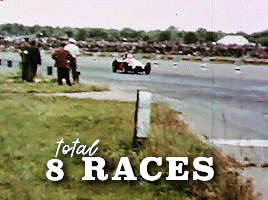




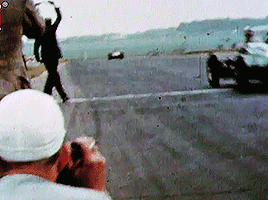
HISTORY OF FORMULA ONE
In gifs
↳ 1951
— Driver’ Champion: Juan Manuel Fangio 🇦🇷 (Alfa Romeo)
— Constructors’ Champion: -
[Full story under the cut]
-
The second season of Formula One saw another Driver in the hands of “The Alfetta” (name given to the Alfa Romeo 158 and 159 cars) win the driver’s championship, but this time the champion was Argentina’s Juan Manuel Fangio. This year though, ended the Alfa Romeo dominance, making this the first year with another team winning races. The British GP at Silverstone saw the first win for the current most successful team in the history of F1: the Scuderia Ferrari, with Froilan Gonzalez (another Argentinean) taking that honor. Ferrari’s Ascari had the race win in Nurburging, Germany and in Monza, Italy; but it wasn’t enough to challenge the lead Fangio had made. Still, the championship was fought all the way to the final race in Pedrables Spain, but a race win there, secured Fangio’s crown.
At the end of the year, Alfa Romeo withdrew from grand prix racing, unable to finance a new car to challenge Ferrari, so the FIA announced that for the 1952 season, the teams would have to run with the current Formula Two rules, trying to prevent an eventual Ferrari domination.

Poster for the season
-
NAVIGATION FOR THE HISTORY OF FORMULA ONE POSTS BY YEAR
Source: The Complete Encyclopedia of Formula One, but written by me [i’m not a native english speaker, so if there are any mistakes please let me know]
Clips used for the gifs: [fangio and the alfetta] [british gp]
* this is a fun hobby, please don’t take this extremely serious as i don’t have all the information
#f1#formula 1#f1edit#juan manuel fangio#historyoff1#year:1951#.g#.mine#for all my other f1 history nerds <3#.history
116 notes
·
View notes
Photo

Juan Manuel Fangio (Alfa Romeo 158, Alfetta) Grand Prix de France - circuit de Reims-Gueux 1950. © Getty - source Carros e Pilotos..
23 notes
·
View notes
Text
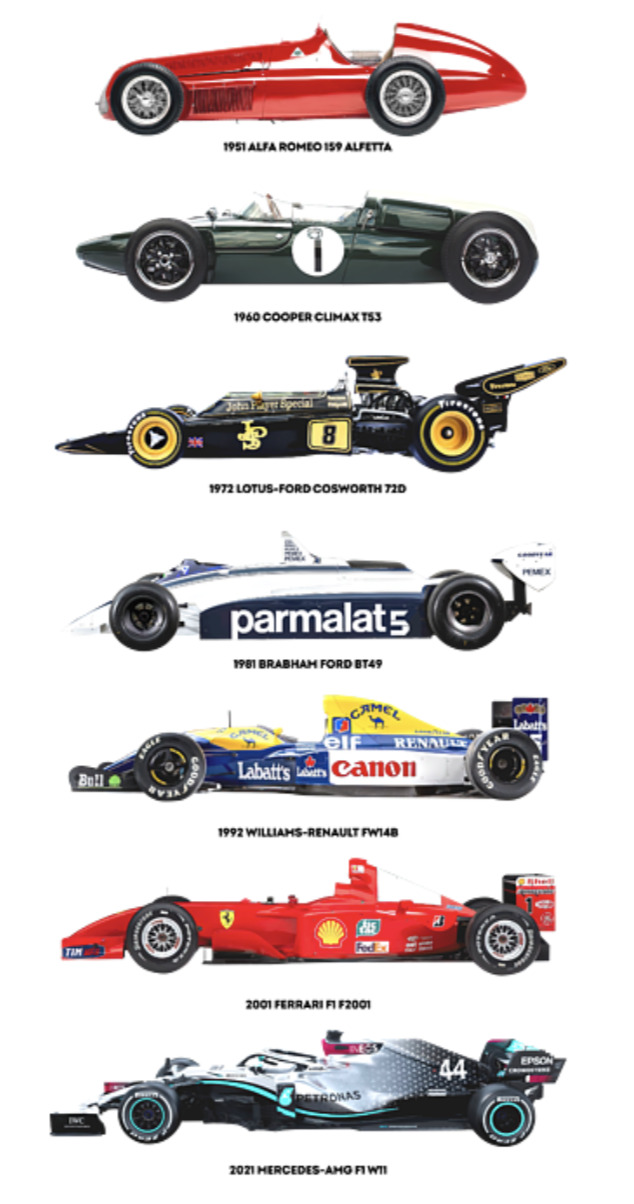
F1 CARS 1950s +
As Formula 1 racing evolved in its first decade, it brought about a lot of change for motorsport. Every season it seemed the rules were changing, in some way, from putting Formula 1 cars into Formula 2, to reducing the size of supercharged engines, to eventual arrival of rear-engined cars at the end of the decade.
Alfa Romeo 158 Alfetta
Racing paused for the Second World War and then, when the fighting was
done, very few people had the cash to build new racing cars. As a result pre- war racers were brought out of their hiding places, dusted off and pressed into action. The Alfetta was now the only real thoroughbred factory racer on the grid and duly swept the floor. Alfettas won the first two F1 seasons at a canter, but it is in 158 guise that it was at its most potent, winning every single F1 race of 1950 (the World Championship also included the Indy 500, which Alfa Romeo did not enter, preventing the team from winning every single race that season) and handing the title to Guiseppe Farina. There was no Constructors’ Championship until 1958, so Alfa wouldn’t double up its titles.
Shapes and Sizes of cars
F1 cars are designed with the smallest possible frontal area
(where the drivers legs go) to minimise drag (friction).
Their length, track, and wing dimensions are defined by the regulations governing F1. The wings, spoilers and general shape, even the underbody are all designed with aerodynamics, downforce and streamlining in mind. The car needs to pass through the air as quickly as possible, gaining as many benefits from it as possible.
However, vintage cars were shaped bigger due to the fact that the motors were not able to be small or hold smaller tanks, hence the bigger car shape.
Old wooden toy cars hold that shape as it is an attractive shape for a car, round and easy to play with
Evolution of F1 CARS
1 note
·
View note
Text
Hace 70 años Juan Manuel Fangio logró el primero de sus cinco títulos en la Fórmula 1
Logró un récord que recién fue batido en el Siglo XXI.
El 28 de octubre de 1951, Juan Manuel Fangio consiguió la primera de sus cinco estrellas en la Fórmula 1. La consagración fue en el circuito español de Pedralbes, donde la categoría realizó la última fecha de su segundo campeonato.
Al igual que el año anterior, en el que terminó subcampeón, Fangio integró el equipo oficial Alfa Romeo. Gracias a la contundencia de la Alfetta 158 de 195 HP comenzó…

View On WordPress
1 note
·
View note
Photo
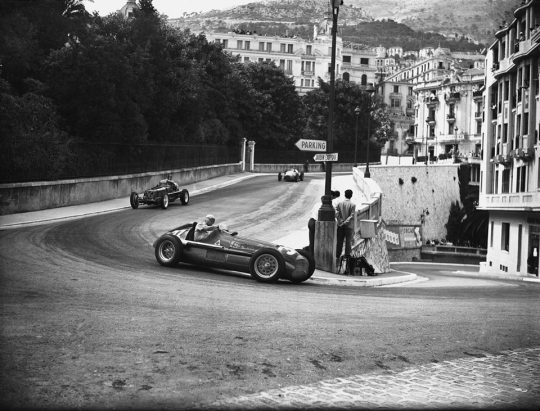

After 69 years, we’re still here
Alfa Romeo at Grand Prix de Monaco in 1950 and in 2019,
with Alfa Romeo 158 Alfetta and Juan Manuel Fangio in 1950 and with Alfa Romeo Racing Sauber C38 and Kimi Räikkönen in 2019.
© Getty Images (2019 by Andrea Diodato/NurPhoto)
#Alfa Romeo#Formula 1#F1#Grand Prix du Monaco#Monaco GP#Montecarlo#Monte-Carlo#Alfa Romeo 158 Alfetta#Alfetta#Alfa Romeo 158#Sauber#Mirabeau#Alfa Romeo Racing Sauber C38#Juan Manuel Fangio#Kimi Räikkönen#1950#'50s#2019
4 notes
·
View notes
Text

Kimi7, Alfa Romeo 158 'Alfetta' 🍀

14 notes
·
View notes


